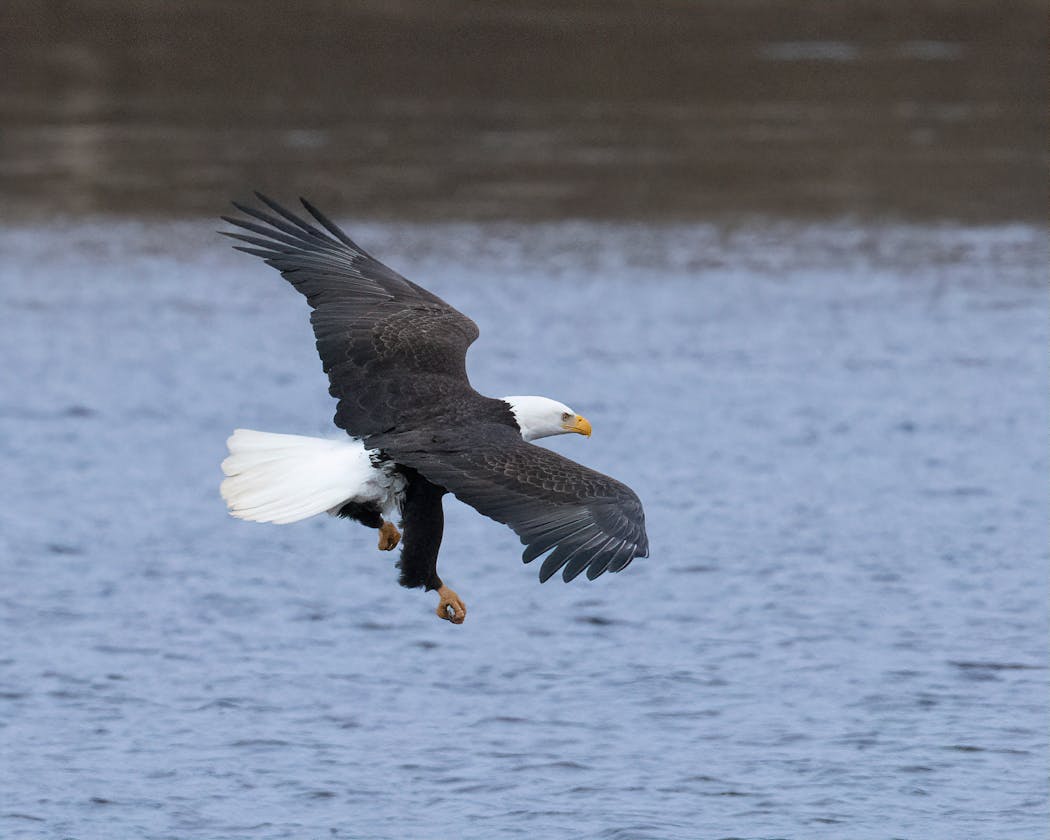Bald eagles fly over Bde Maka Ska and Como Lake on a daily basis, they wheel above metro freeways and perch in trees along the Mississippi River.
They're now almost an everyday sight, but just 30 years ago things were very different. As recently as the 1960s, almost no one saw a bald eagle anywhere in Minnesota (or elsewhere in the U.S.).
But once we humans put the brakes on things that threatened their survival, bald eagles came roaring back. In fact, the U.S. Fish and Wildlife Service's recent estimate shows four times as many bald eagles as were reported 10 years ago in the continental United States, outside of Alaska. The agency reported more than 316,000 bald eagles last year, an astonishing number and a surprise to many.
That number includes something like 143,000 paired eagles raising youngsters and 174,000 unpaired eagles, either young birds or those that haven't found a mate.
(The federal agency used a combination of methods, from aerial surveys to the Cornell Lab of Ornithology's sophisticated data modeling, to come up with its population estimate.)
Compare this with the early 1960s, when there were only 417 nesting pairs in the entire contiguous United States. There were so few eagles back then that it began to look as if we'd have to go to zoos and nature centers to see them in the future.
The 1972 ban on the pesticide DDT and decades of protections paved the way for today's eagle boom. The recent estimate shows real population growth, experts say, not merely improvement in data collection (it's not all that easy to count eagles across our vast country, so estimates are key).
John Moriarty goes up in a small helicopter (with a pilot) each spring to count eagles nesting along the Mississippi River from Dayton to Prescott, Wis., and his eyeball census found 49 occupied nests this spring. Moriarty, senior manager of wildlife for Three Rivers Park District, has seen steady growth in the 15 years he's been doing these aerial surveys, but knows that many eagles escape notice.
Eagles in metro area
"If we counted all the nests in the seven-county metro area, there'd easily be over 200 active nests," he notes. Think of it: 400 bald eagles raising their families around us.
Victoria Hall, executive director of the Raptor Center, is encouraged by the increase in bald eagles.
"The story of the bald eagle is an extremely encouraging tale of bringing a species back from the brink of extinction," says Hall. "It shows the incredible force for good that comes when multiple organizations and the public come together to save a species."
We humans can pat ourselves on the back for helping the bald eagle population recover (while keeping in mind that we're the ones who nearly drove them over the extinction cliff), but eagles still face threats — chief among them the lead shot used by many deer hunters. After a successful hunt, many hunters leave behind gut piles that often contain lead pellets, a highly toxic metal, and as eagles scavenge on this, they may ingest lead.
Lead sickens eagles
"Far and away, lead poisoning is the greatest issue we see, with 85 to 90 percent of the patients coming into our hospital having some measurable level of lead in their blood," says the Raptor Center's Hall. She added that once an eagle begins to show signs of lead poisoning, it usually will not survive, despite intensive care.
"It's so frustrating because it is completely preventable," notes Hall. A switch to non-lead ammunition, such as copper or steel, would help protect eagles (and hunters and their families, also vulnerable to lead poisoning).
None of us wants to live in a world without these big black and white raptors, and we've already seen how close bald eagles came to vanishing. We took steps to save eagles before, and we can do it again: If we get the lead out of the environment, we'll continue to have eagles living among us.
St. Paul resident Val Cunningham, who volunteers with the St. Paul Audubon Society and writes about nature for local, regional and national newspapers and magazines, can be reached at valwrites@comcast.net.
Eagle info
Visit the Minnesota Department of Natural Resources' eagle cam website for more information about bald eagles. This year's two youngsters have left the nest, so bookmark the site for next year's nesting season: dnr.state.mn.us/features/webcams/eaglecam/index.html
Top eagle states
Estimate of nesting pairs of eagles, state by state:
Alaska: 30,000 pairs
Minnesota: 9,800 pairs
Wisconsin: 1,500 pairs
Florida: 1,500 pairs

Critics' picks: The 11 best things to hear, do and see in the Twin Cities this week

Critics' picks: The 9 best things to do and see in the Twin Cities this week

The 5 best things our food writers ate this week

The 5 best things our food writers ate this week



